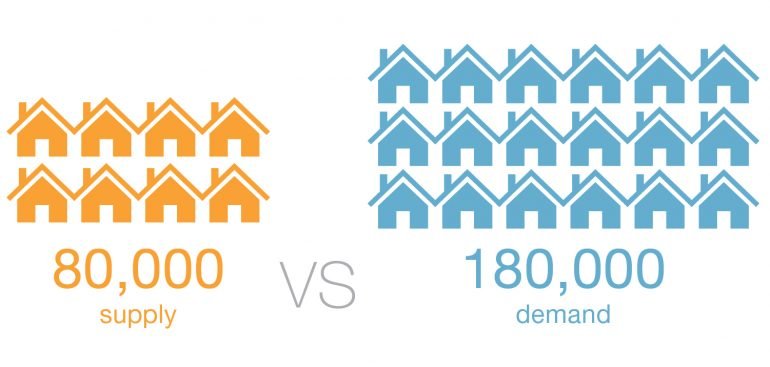In this time of global unrest, global warming, and global pandemics, Californians are working to address another crisis: the challenge of housing at the local level. ESA is working closely with communities to help address this crisis, striving for the provision of adequate housing for all residents.
As public health concerns increase, and both political and social unrest intensifies, the events of 2020 continue to flood our newsfeeds. As a result, the spotlight on the housing crisis has temporarily diminished, but the problem remains.
To some, California is a shining example of economic opportunity and climate policy implementation. While that may be partially true, in this time of global uncertainty, California has fallen behind in terms of housing opportunity. With a lack of housing options and adequately zoned sites, housing shortages, staggering income inequality, high housing rental costs, lower rates of homeownership, and disproportionate numbers of Californians facing homelessness, solutions are challenging. However, with state leadership guiding the way, the Department of Housing and Community Development (HCD) has identified a number of issues as well as strategies to address some of the housing challenges facing the state. While seemingly overwhelming, California’s housing crisis is a complex yet solvable issue that will require the collective efforts of many.
Tools for Housing Implementation at the State and Local Levels
As part of local General Plans, the Housing Element is one of eight mandated General Plan elements, and each Housing Element must be certified by the State of California. Housing Element law mandates that local governments adequately plan to meet the existing and projected housing needs for all economic segments of the community. Though required by state law, this element is implemented at the local level. The current update cycle for the Housing Element is the sixth cycle, which includes specific requirements for housing production. Over the last ten years, housing production in California has resulted in 80,000 or fewer new homes each year, with ongoing housing production projected to fall below the estimated need of 180,000 additional homes annually. Therefore, not enough housing is being built in California to keep up with demand.

The Housing Element provides conditions for conserving, preserving, and producing an adequate supply of housing affordable at a variety of income levels. Further, the Housing Element establishes a jurisdiction’s strategy to plan for and facilitate the development of housing over the five- to eight-year planning period by providing implementation programs and an inventory of land adequately zoned or planned to be zoned for housing. The purpose of the Housing Element’s site inventory is to identify and analyze specific land (sites) that can be available and suitable for residential development. This process helps determine the jurisdiction’s capacity for accommodating residential development and reconciles that capacity with the jurisdiction’s Regional Housing Need Allocation (RHNA). ESA works with jurisdictions in compiling the inventory of sites to help determine whether there are sufficient adequate sites to accommodate the RHNA by income category, and the strategies to meet the goals of local jurisdictions.
A local Housing Element is only one tool used to facilitate housing production. The State has also adopted policies in response to these housing challenges to help accelerate housing production, including enacting new housing legislation with 14 bills that constitute the 2017 California Housing Package and 30 individual pieces of housing legislation in 2019 that were enacted into law. Some of the bills directly influence Housing Element preparation, while others establish tools, programs, and funding mechanisms that may be applied to help support the creation of varied housing types.
In addition to legislative tools supporting housing production, the State’s Housing Action Plan outlines some of the steps that are being taken to address these issues. These steps include policies to reduce local barriers for permit review, lowered rental housing costs, and reduced barriers to public investment.
ESA’s Planning Services
Comprehensive, Long Range Planning
General Plans
Specific Plans
Master Plans
Downtown Plans
Zoning Regulations
Design Guidelines
Local Coastal Programs
Land Planning and Design
Site Analysis
Yield Studies
Policy Analysis
Preliminary Design
Strategic Entitlement
Sustainability and Resilience Planning
Climate Action Plans
Climate Vulnerability Assessments
Climate Adaptation Plans
Sustainability Plans
Resiliency Plans
Public Outreach and Community Engagement
Public Engagement Plans
Community Workshops
Online Engagement
Surveys, Pop-ups, and Interviews
ESA’s Facilitation of Housing Production
ESA has a long history of working with regional entities, local jurisdictions, and developers to provide analyses and tools in support of housing site analysis, due diligence research, and environmental review for compliance with the California Environmental Quality Act. While we are currently in the sixth cycle, and the first cycle of Housing Element updates under the new housing legislation, ESA has been actively involved in applying housing best practices and understanding evolving housing law throughout the prior cycles. In addition, ESA has worked on a number of more recent projects, such as the Placer County Housing Strategy and Development Plan (2019), Napa County Housing Sites Inventory Study (2020), and Pico Rivera Housing Element analysis for compliance with new housing legislation (2020).
ESA works with local jurisdictions to apply innovative solutions for housing development, including environmental review for housing site selection, and analysis relating to the provision of fair housing, gentrification, displacement, and other housing issues. Although there are many challenges, ESA is adept in its efforts to analyze potential housing opportunities. These opportunities include the identification of housing sites as part of an online mapping tool for the City of Sacramento’s Central City Specific Plan and the development of SACOG’S Transit Oriented Development (TOD) Toolkit for use by jurisdictions as a reference for helping to implement housing near transit.
Outlook for the Future
The lack of housing supply, in conjunction with a scarcity of land and an increasing population, has led to rising housing costs. In turn, this has compounded income inequalities for disadvantaged communities and limited opportunities for younger generations of Californians. Without intervention, much of the new housing growth is expected to be focused in areas where fewer jobs are available to the families that live there. In the long term, addressing the costs of housing at the state and local levels will happen through reform and actions relating to land use policies in support of affordability, sustainability, and equity.
ESA understands that providing housing access for vulnerable populations is of paramount concern, and that achieving this goal will require more effective public-private partnerships and strengthened interagency coordination. Local jurisdictions and state funding sources will need to provide investment in affordable home development and rehabilitation, rental and homeownership assistance, and community development. Through our ongoing efforts, ESA is committed to actively working with clients to assist in addressing these housing challenges.







